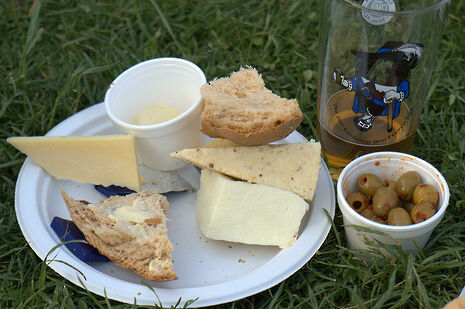Bacteria Bouquet III: bread, beer and cheese
In this week’s Bacteria Bouquet, Zi Ran Shen looks at the bacteria in our food

As autumn colours enveloped Cambridge, I took a walk to enjoy the falling leaves and find inspiration for this week’s star bacteria. With the dropping temperatures comes harsher conditions, fewer microbes, and less inspiration. I walked around the Cam, but the river has so many critters in it that I could write a whole dissertation. I walked around the Corpus clock, but unfortunately it features a giant bug and not a giant bacterium. After two misses, I ended up in the market dejectedly scouring for comfort food. As luck would have it, my muse came to me in the form of bread, beer, and cheese. What do those things have in common? Bacteria, of course!
Lactobacillus is a genus of bacteria which are essential in food production. These guys are the not-so-secret ingredient in the tangy taste of sourdough, the acidity in yoghurt, the sharpness of cheddar, and the tartness in Berlin craft beer. Lactobacillus works by converting sugars into lactic acid, which is what gives the finished food products a sour taste. Depending on the sugar it consumes, the breakdown products will also have a variety of interesting flavours.
In sourdough bread, lactobacillus either replaces or works in conjunction with yeast to leaven the bread. Rye was the original flour that received this special treatment. Rye flour does not contain as much gluten as wheat, which makes higher order sugars the basis for its structure. The enzymes in rye that break down starch and other complex sugars are much more robust than wheat, withstanding higher temperatures while baking. As the starch breaks down, the structure of bread breaks down as well. This is where Lactobacillus saves the day. Lactobacillus breaks down simple sugars in the bread, creating acid in the process. The acid created inactivates enzymes in the wheat, thereby retaining the structural integrity of the bread. Not only do these bacteria create an interesting flavour profile, they maintain the texture of the crust and crumb.
In cheese, Lactobacillus helveticus is used to create the distinct nuttiness in cheeses such as Parmesan, Emmental, and cheddar. In the ripening step, Lactobacillus bacteria are added to milk to create the aroma surrounding cheese. In this essential step, these bacteria not only break down simple sugars, but also proteins and other bio-organic molecules in the milk, creating a variety of aromatic compounds that define the cheese being made. To curdle the now flavourful milk, a concoction of calf stomach enzymes is used. Being from the stomach, the enzymes need an acidic environment to function. It is of the utmost importance, then, that the Lactobacillus be present to create lactic acid. Without Lactobacillus, nutty firm cheese would turn into flavourless milk goo, and that is not a culinary experience I would ever sign up for.
With the growing population of craft beers comes a dazzling array of choice. Styles of beer that were only regional are now internationally popular. From this new beer craze is born another stage for the versatile Lactobacillus: the sour beer. Sour beer is made from introducing Lactobacillus into the fermentation process, thereby adding acidity to create the tart taste. The acidity helps balance the bitterness and sweetness in alcohol to create a complex flavour profile sought after by many. Who knew that these bacteria could be so sought after in the culinary world?
The microbes that inhabit our foods are vast and mighty. Though Lactobacillus plays a dominant role in food production, let’s not forget their humble friends that make foods including chocolate, coffee, tea, wine, sausage, and many more. Although usually thought of as the culprit in food spoilage, bacteria are instrumental in the creation of various foodstuffs that tickle our palate. Bacteria can be both friend and food!
 News / Uni Scout and Guide Club affirms trans inclusion 12 December 2025
News / Uni Scout and Guide Club affirms trans inclusion 12 December 2025 News / Cambridge Vet School gets lifeline year to stay accredited28 November 2025
News / Cambridge Vet School gets lifeline year to stay accredited28 November 2025 Science / Did your ex trip on King’s Parade? The science behind the ‘ick’12 December 2025
Science / Did your ex trip on King’s Parade? The science behind the ‘ick’12 December 2025 News / Cambridge study finds students learn better with notes than AI13 December 2025
News / Cambridge study finds students learn better with notes than AI13 December 2025 News / Pembroke to convert listed office building into accom9 December 2025
News / Pembroke to convert listed office building into accom9 December 2025







